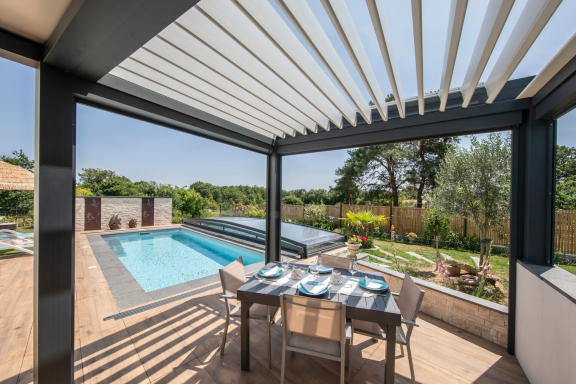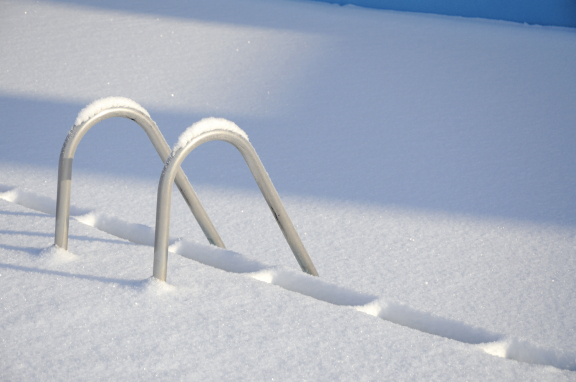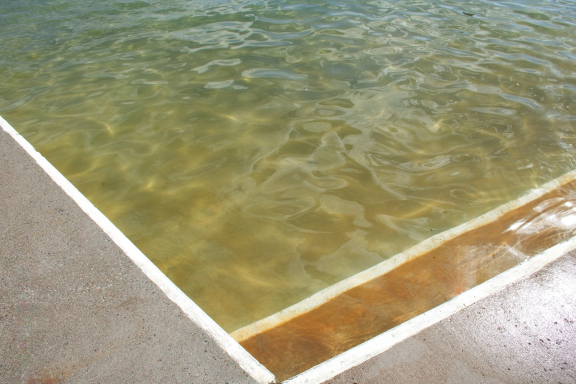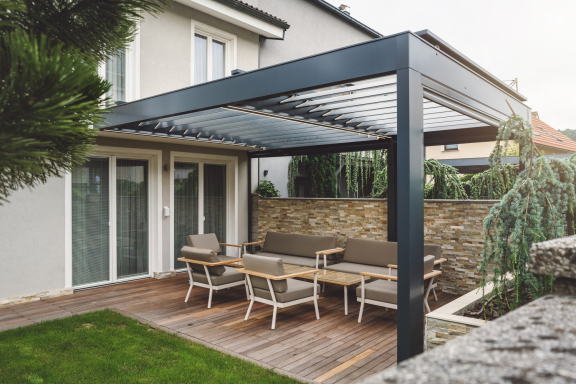How should you go about choosing your bioclimatic pergola?
Thanks to its numerous benefits, the bioclimatic pergola has become a feature in a host of gardens around the country. Whatever its shape, its colour and its use, the bioclimatic pergola offers a space that's shaded and/or sheltered from bad weather to everyone who adores making the most of their outdoors and is looking for a terrace cover. SO, are you thinking about joining the bioclimatic pergola owner community? Here's some advice to help you choose your bioclimatic pergola based on your personal situation.
Choosing which material to use for your bioclimatic pergola
This is one of the first questions you'll need to ask yourself when choosing your bioclimatic pergola: which material should you favour for manufacturing your bioclimatic pergola? Although there are steel bioclimatic pergolas on the market, most models sold nowadays are made from aluminium. And, it has to be said that aluminium as a material for a bioclimatic pergola has a number of benefits over its rivals, such as:
- ever-so little, ever-so easy cleaning;
- exceptional service life ;
- a wide array of colours and styles;
- incredibly lightweight;
- highly-resistant to bad weather.
Worth noting is that, given the particular features of the bioclimatic pergola (adjustable slats), it's quite difficult to imagine a bioclimatic pergola made of wood. If you prefer this material for your outdoor installations, then, more often than not, you'll have to settle for a traditional pergola. Likewise, PVC and wrought iron aren't really up to scratch when it comes to bioclimatic pergolas.

Choosing your bioclimatic pergola based on your uses…
The bioclimatic pergola, initially intended to create a shaded outdoor space protected from bad weather (rain and wind), now exists in a host of models that address different needs. The use you wish to make of your bioclimatic pergola will determine the model you should choose. Nowadays, you can think about installing a bioclimatic pergola for:
- extending your living room, lounge area, kitchen, etc. onto the outdoor world;
- protecting your terrace from too much sunshine and, as such, having a shaded outdoor space;
- protecting your garden furniture when it rains, and being able to leave it outdoors all year round;
- having a lounging area at the end of your garden, where you can relax and spend time reading, without being disturbed;
- hosting a spa;
- having a covered area close to your pool;
etc.
… and, based on where it's installed
The place you choose to install your bioclimatic pergola is another decisive factor when choosing your pergola model. Thanks to free-standing models, as a new bioclimatic pergola owner, you can set up your pergola:
- as a standalone structure, for example at the end of your garden, to create a relaxing space far from any noise that may come from your home;
- as a lean-to, against a façade of your home, to extend an indoor living space outdoors.
Based on the configuration of your garden and/or home, and based on your desires, you'll have to choose the place you think would be most suitable to install your bioclimatic pergola. It's worth mentioning however that, for bioclimatic pergolas intended to be used to cover a terrace, it's often recommended to leave a part open to optimize its ease of use.
Choosing the size of your bioclimatic pergola
The size of the bioclimatic pergola is another vital aspect to take into account when choosing a pergola model. The space to be covered largely determines the size of your bioclimatic pergola. Your needs, the space taken up by your garden furniture, as well as any urban planning rules and regulations in effect in your municipality, can also impact the size of your bioclimatic pergola.
In most French municipalities, installing a bioclimatic pergola with a footprint of between 5 m2 and 20 m2 only requires you to declare this to your local town hall. For larger bioclimatic pergolas (with a footprint of over 20 m2), a building permit is often required. On the other hand, a small bioclimatic pergola with a footprint of less than 5 m2 doesn't require any administrative declaration. In any event, it's important to define the right size for your pergola (height, width, overhang) with the help of a professional. As installing a bioclimatic pergola will have an impact on the outdoor look of your dwelling, it's also advisable to check urban planning rules and regulations beforehand to know what you can or can't do as such.
Choosing how to position the adjustable slats of your bioclimatic pergola
The integrated adjustable slats are one of the key features that explain the huge success of the bioclimatic pergola in recent years. These slats let you play with light and with the level of sunshine. By moving the angle of the adjustable slats a few degrees, you'll let more (or less) sun shine onto the pergola and invite more (or less) sun rays into your home (for lean-to models). By moving these adjustable slats, you'll also be able to control the temperature of your pergola (by opening up the slats, you'll create a current of air that will refresh the air in the pergola), and protect yourself and your furniture from the rain. The only thing you need to know to make the most of the slats of your bioclimatic pergola: choose the right orientation. When choosing your pergola, you'll therefore need to take into account the sun's exposure and the path it travels throughout the day to decide on the orientation of your bioclimatic pergola slats.
Choosing options for your bioclimatic pergola
Now that you've specified the size, the location and the model of your bioclimatic pergola, you can go even further as regards its installation and take a look at the various options open to you. On most bioclimatic pergola models on the market today, you'll have a great choice when it comes to the level of comfort and safety you want, and a host of options more or less tailored to your situation. So, if you'd like your bioclimatic pergola to be bespoke, you'll have the opportunity to opt for:
- motorization for the adjustable slats of your bioclimatic pergola: this option is frequently included in bioclimatic pergola models. Yet, you can choose the type of motorization you wish (traditional or connected), and you can choose the motor, which will be more or less noisy when used;
- rain, wind, frost and snow sensors: some bioclimatic pergola models integrate different types of sensors that open and close the slats automatically depending on the weather scenario. Just like home automation equipment, you'll be able to control and/or remotely programme the opening and closing of the slats when there's rain, wind, etc. via your smartphone;
- vertical blinds, glazing and/or sliding panels: your bioclimatic pergola can accommodate several vertical blinds, glazed panels and/or sliding panels. The aim: to protect you more from the wind and the rain, as well as to offer you a solution for optimal privacy and to be protected from prying eyes and the outside world;
- heating: some bioclimatic pergola models can be equipped with an integrated heating solution. An option that's really useful to make the most of your outdoors: even when the temperature drops, you won't be obliged to go fetch a pullover or to finish the meal you started outdoors indoors;
- LED lighting: when you have integrated lighting in your bioclimatic pergola, you'll be able to spend time in it even after dusk sets in and, more often than not, lighting comprises a dimmer that's perfect for relaxing.
When it comes to choosing options for your bioclimatic pergola, your wishes, your needs and your budget will be key to making up your mind.

Choosing the colour of your bioclimatic pergola
The final aspect to take into account when choosing a bioclimatic pergola is the colour. Most manufacturers now propose an extensive range of colours for their bioclimatic pergola models and you'll often have the choice between dozens or even hundreds of shades. As such, as a future bioclimatic pergola owner, you'll be spoilt for choice:
- go for a bioclimatic pergola that matches your existing architecture style-wise (pergola colour identical to your façade colour, for example), so it blends harmoniously into your setting;
- go for a bioclimatic pergola colour that contrasts totally with already-existing hues (a black lean-to bioclimatic pergola against a white façade), to emphasize the structure and highlight the existence of your bioclimatic pergola.
It should be noted that when a bioclimatic pergola is subject to an urban planning declaration or building permit (see above), some colours may not be accepted. To avoid unpleasant surprises, it's advisable to find out everything you need to know beforehand about the architectural possibilities (shapes, sizes, colours, etc.) allowed by your municipality for bioclimatic pergolas and outdoor installations. For those of you who wish to customize your bioclimatic pergola even more, it's worth knowing that several manufacturers even let you choose the colour for your adjustable slats. Nonetheless, for optimal use of your bioclimatic pergola, white is still the colour of choice.


